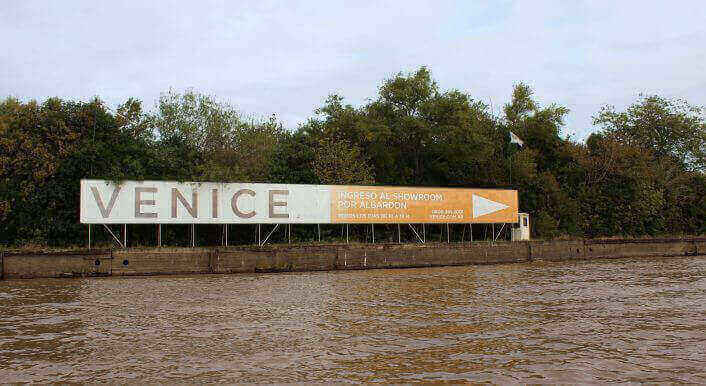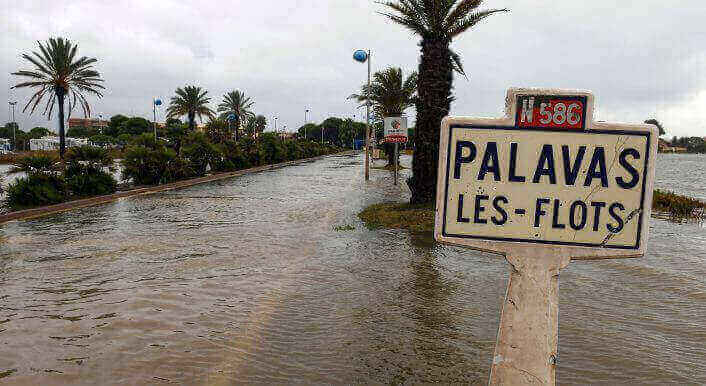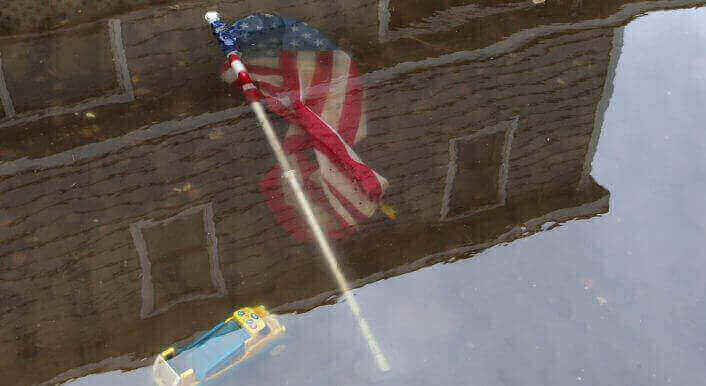Argentina: Where the rich and poor will sink together
The delta of the Rio Paraná, just outside Buenos Aires, was once barely populated. That was, until the real estate developers came - and the islands in the wetlands were marketed as luxurious waterfront properties. The consequences were disastrous.
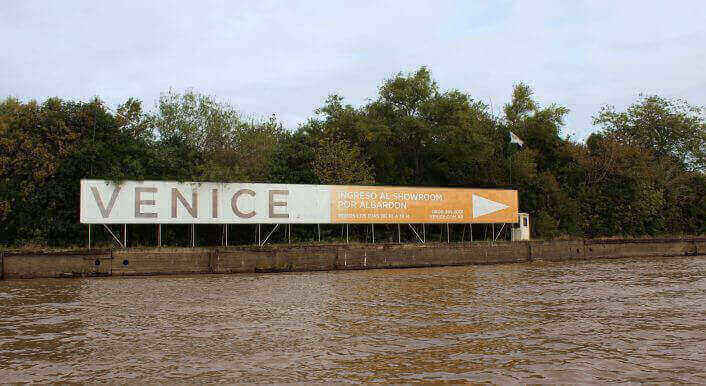
When storms strike the Buenos Aires’ slum of Garrote, Marcela Creciente’s kids know the drill: they climb to the roof of their home where Creciente has laid out mattresses for them to rest upon while they wait for the rain to pass.
She puts them there to keep them out of the filthy, flooded streets below, where the water can rise to waist level, and garbage flows by at a steady pace. From this viewpoint, they watch as their neighborhood comes to a standstill — power interrupted and sewage pouring into the streets, blocking the roads and preventing anyone from coming in or going out.
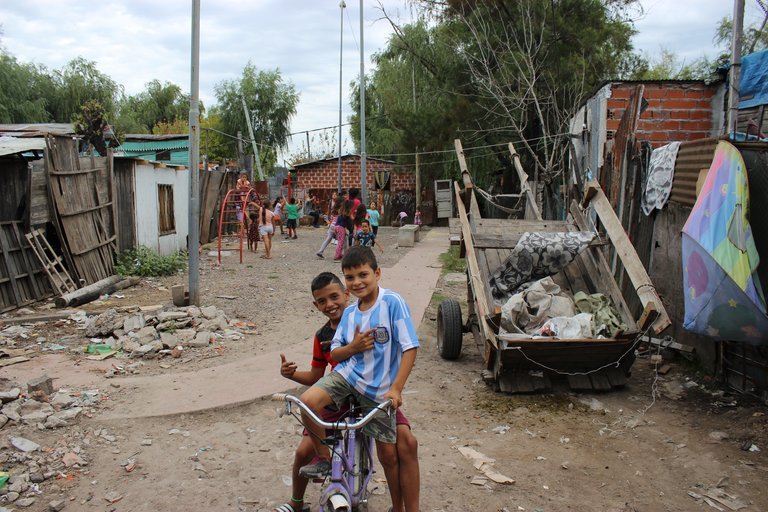
Kids in Garrote
Gilda Di Carli
Yet, less than a mile away, just north up Italia Street, a new development designed for the Argentinian capital’s elite is being built on the same river delta as Garrote.
In an irony not lost on Creciente and her neighbors, its designers envision the $23 million residential community, called Venice, as an aquatic neighborhood — a city built atop the water, with canals instead of roads, just like Italy’s famous city — but with a modern twist: instead of gondolas, small yachts will dock outside the wealthy patrons’ condos.
“Deciding to name the project Venice is almost mocking“, said Patricia Pintos, a geographer and expert on real estate development on the Paraná delta wetlands. „During extraordinary floods, many lower-class neighborhoods actually resemble Venice [with canals instead of streets] so it feels like they’re taunting them“, she said.
And when the new development is complete, on those rainy nights when Creciente’s children rest and wait on their soggy mattresses, Venice’s residents will be sheltered safely inside their luxury condominiums, admiring the weather through double-paned, vista-filled windows- unaware their presence, and the development they have spent hundreds of thousands of dollars to live in, may only make things worse for their neighbors in Garrote.
In 2014, a team of public interest lawyers brought the Venice project investors to court, alleging the high-end complex may aggravate flooding in Garrote.
Although both Garrote and Venice were built atop flood-prone wetlands in the Paraná river delta, it is the new, high-end developments — like Venice — that lawyers claim are not only built illegally, but as a result of their design, will exacerbate the flooding of the older and poorer communities nearby.
With over zealous dredging, and the introduction of landfill, artificial lakes and floodwalls, these new developments- many illegal and badly planned- will alter the delta’s runoff, diverting it toward lower-lying communities, such as Garrote.
And as global temperatures rise and glaciers and poles melt, rising seas, stronger storms and increased storm surges will make the already devastating flood situation significantly worse for these delta communities.
Correctiv, a German nonprofit investigative journalism news organization and the Columbia University Graduate School of Journalism’s Energy and Environment reporting project, have examined tide gauge data from the Permanent Service for Mean Sea Level (PSMSL) for the Buenos Aires region. Although there are very few gauges in the region, the available data shows that sea level has been rising in the area at a rate of 1.7 mm per year over the past fifty-seven years. That’s a roughly 9.5 cm increase since 1961- a trend scientists say is only likely to accelerate in the future, leaving the Paraná river delta, and the communities within it, even more vulnerable to flooding and storms.
The delta is on the path to becoming submerged, said Jorge Codignotto, a leading scientist on sea level rise at The National Scientific and Technical Research Council (CONICET)a leading scientist on sea level rise at the National Institute of Industrial Technology in Buenos Aires, and even the new developments, he said, will eventually be lost.
Geography of Paraná river delta
The Paraná delta is the planet’s only river delta that does not drain into the sea, but instead, another river, the Río de la Plata. The delta is roughly 14,000 square kilometers in area, and dotted with more than a thousand small islands – the result of sediment carried 1,000 kilometers downstream by the South American river as it snakes its way from its headwaters in Brazil, southward along the border of Paraguay and into Argentina.
Crisscrossed with dozens of smaller rivers, including the Luján river, the wetlands and marshy islands of the delta, have served to temper the fluctuating water levels of both the Paraná and the Río de la Plata. And for decades, only the most marginalized communities – such as early residents of Garrote and towns like it – resided in this flood-prone, buggy, and swampy environment.
But that all changed about two decades ago, when the southeast corner of the Paraná delta, Tigre, caught the attention of developers looking for new, exotic and cheap land to build upon. Tigre was one among many towns, like Pilar, Campana, and Escobar, targeted for development.
Today in Tigre, among islands thick with vegetation, where ceibos — the national tree- and herons nest, nearly 100 gated communities have been developed, turning the once remote and unglamorous marsh into a tourist attraction.
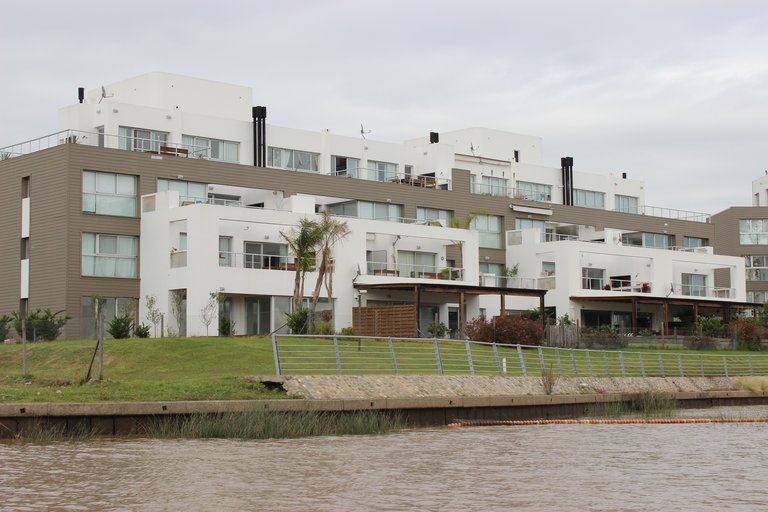
Over 9,000 hectares of wetlands have been cleared for real estate projects at the Luján river’s basin.
Gilda Di Carli
Development of Tigre
Developers of Nordelta, pioneers of Tigre’s gated communities, submitted their first lot for construction in 2000. Within 15 years, this large-scale gated community grew from a few resident herons and ducks to more than 30,000 human residents, according to the development’s website. Nordelta, one of the largest communities, encompasses a surface area of 1,600 hectares, which is roughly four-and-a-half times larger than New York City’s Central Park.
Nordelta was soon followed by dozens of others including Marinas Golf, Complejo Villanueva, El Cantón.
All were built for wealthy buyers — with many serving as weekend or vacation homes, according to Diego Ríos, an expert on the developments in this area.
Over 9,000 hectares of wetlands -about half the size of Washington D.C.- have been cleared for real estate projects at the Luján river’s basin, according to Patricia Pintos, a researcher in geography at the University of La Plata in Buenos Aires. She and a team of researchers authored a report, The Sacrilegious Privatopia, on real estate development on the Paraná delta wetlands. And the speed and scale of development is increasing, nearly 1/4 of these wetlands were cleared between 2012 and 2014.
Flooding
But as development booms, so does flooding.
In March 2010, heavy floods hit low-lying neighborhoods in Tigre — meter high waters flooded ground floor apartments, destroying fridges, doors and walls, according to local news reports. Some residents in Tigre claimed one of the gated communities had opened a floodgate, redirecting water into a nearby middle-class neighborhood, according to the local newspaper, Actualidad de Tigre.
As a result, the Tigre municipality ordered two gated communities to design drainage infrastructure, such as dams, canals and levees, to alleviate the impact of flooding, and prevent runoff from pouring into poorer communities, reported the local newspaper.
But things got worse.
In June 2012, a Buenos Aires newspaper reported Garrote was in the midst of a public health epidemic as a result of contaminated waters filling the neighborhood streets.
Creciente recalled that dredging by developers earlier that winter along the Luján river brought a murky muddy mixture onto the bank of the Canal San Fernando. When it began to rain, the churned-up mud seeped into places where children played. Before long, the children became sick. Parasites were observed in children’s diapers.

Today in Tigre nearly 100 gated communities have been developed, turning the once remote and unglamorous marsh into a tourist attraction.
Gilda Di Carli
“Children were vomiting parasites from their mouths“, said Creciente. One case of parasites was detected in a woman who was seven months pregnant.
Between 2012 and 2017, flooding not only became commonplace, but increasingly accompanied by civil unrest.
For instance, in 2013, as floods swelled along the delta, residents of a middle-class neighborhood near Nordelta broke through a wall surrounding the gated community’s golf course in order to relieve the rising waters submerging their homes. Nordelta security guards shot at them. No injuries were reported.
And in 2015, nearly 20,000 residents from several towns were evacuated- including Las Tunas- and three drowned, according to Clarín, a national newspaper.
These municipalities were hit again in 2016 and early 2017.
Investigation
Concerned by the constant flooding, lawyers and scientists began investigating the relationship between real estate development and flooding on the delta.
They discovered that many developers were not only shirking provincial and federal laws – in some cases with the help of local municipalities – but publicly bragging about it.
For instance, in 2014, a team of public interest lawyers found that while the company developing Venice had submitted environmental impact statements to the city of Tigre, it had failed to provide provincial authorities with those documents- a violation of the law. So they sued both the city and the developers.
The developers had publicized this violation in sales brochures.
“The sense of entitlement is so normalized that they have no problem mentioning in their company advertisement that 60% of their condos had been sold before they had the permits to build“, said Eduardo Reese, director at Centro de Estudios Legales y Sociales, the law firm filing suit.
A Tigre municipality spokesperson denied any wrongdoing.
Still, Pintos, the researcher who authored the Paraná delta real estate report, and her team have shown that non-compliance and lack of enforcement are rampant in the development of gated communities similar to Venice.
For instance, developers of San Sebastián, a gated community spanning 9 km along the Luján river excavated wetlands, introduced landfill, built floodwalls and created artificial canals and lagoons without one certified permit, and in violation of more than 10 laws regulating wetland development.
And San Sebastián is not alone. As of December 2014, 66 gated communities on the Luján river basin were non-compliant, according to Pintos’ team.
In 2016, two federal judges filed a decision halting construction in more than a dozen of these communities, including Venice.
The decision required provincial authorities to prevent any new construction in these municipalities until environmental impact statements were submitted that analyzed the cumulative impact of these gated communities on wetland flooding.
As a result, several projects were modified.
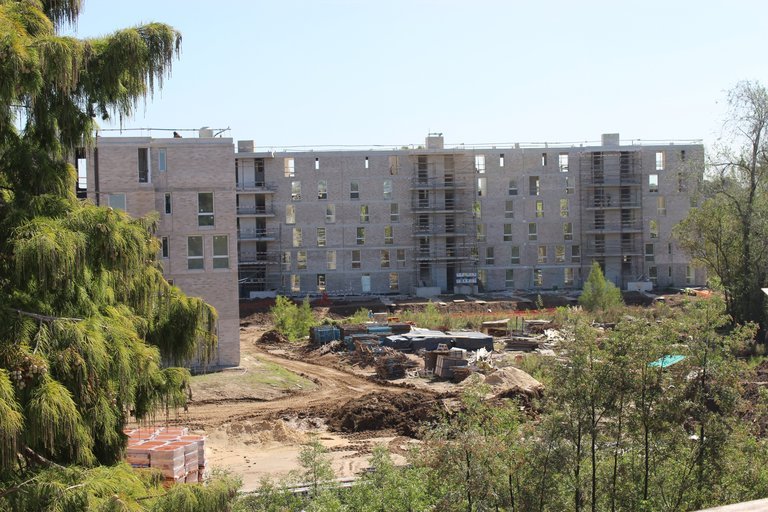
In 2016, two federal judges filed a decision halting construction in more than a dozen of these communities, including Venice.
Gilda Di Carli
In the case of Venice, not only was the development’s footprint reduced, but the developers were required to incorporate flood control measures and restore wetland vegetation, according to Juan Paladino, provincial government coordinator.
The development is now under construction and fully compliant, said Pablo Botana, managing director for TGLT, the developer of the Venice project. He noted Venice is different from most other gated communities because instead of being built atop virgin wetland, it is located on an abandoned shipyard, where large boats were built and repaired over the course of the century.
However, not everybody is satisfied.
Researchers say the cumulative impact of these developments is still being ignored, despite the courts’ requirements, and as a result, the health of the wetlands environment is threatened.
“It’s not possible to argue that an isolated project will not have an effect on the flooding dynamic“, said Pintos. „We have to watch the whole movie, looking at just one take is not enough.“
For instance, Diego Ríos, an expert on the Paraná delta, is looking at the effect chemical fertilizers, artificial lakes and weed killers are having on the delta’s fragile ecosystem. He found they are contributing to the production of a toxic algae known not only to kill native plants and animal, but that may threaten human health, as well.
His study shows these blooms produce noxious odors, skin rashes, diarrhea, vomiting, cramps, and even death.
Complaints regarding greenish blue, fluorescent colored algae emitting the smell of insecticide surfaced in Nordelta as early as 2005. Biologists note that water pumps to eliminate the algae have little effect so long as agrochemicals are used to maintain lawns green year-round -especially in the case of golf courses.
“It’s a problem that never ends, like a snake that bites its tail“, said Ríos.
Government’s role
There is hope, however, for the delta’s health.
In 2016, Argentina’s president, Mauricio Macri, a center-right politician promoting liberal policies, introduced a wetlands protection bill designed to conserve Argentina’s 600,000 square kilometers of wetlands– nearly ¼ of the country’s surface area, including the Paraná delta.
Recognizing that flooding is Argentina’s costliest environmental issue, according to the World Bank, the bill will prevent farmers, cattle ranchers, and developers from destroying flood-preventing wetlands.
Despite strong backlash, the bill was given preliminary approval in the Senate, and is now awaiting final approval in Congress.
In addition, the Paraná river delta is protected by an international treaty known as the Ramsar Convention on wetlands. The treaty stipulates that the delta can’t be reduced in size without notification.
“To this date we have received no report on any changes made there“, said Maria Rivera, Senior Advisor for the Americas for the Ramsar Convention on Wetlands.
Yet, scientists warn such conservation developments may have come too late to save the delta and its residents.
Climate Change
Geographers and meteorologists say sea level rise, as well as other climatic changes, such as storm frequency, and changes in wind and weather patterns, increase the urgency and need to prepare for and prevent damage to all the communities in the Paraná delta.
“We’re not suggesting we leave this place untouched“, said Jorge Codignotto, a leading scientist on sea level rise at the National Institute of Industrial Technology in Buenos Aires. ‘We just don’t want to lose the few natural resources we have.“
As seas rise and storm intensities increase, it won’t just be the poor communities that get clobbered, it’ll be all of them.
According to a study conducted by University of Buenos Aires, sea level has risen 20 cm in the last century at the Río de la Plata. Such a significant increase has and will continue to have a direct impact on the Paraná delta wetlands, said Codignotto.
In a spacious wooden office at the National Institute of Geography in Buenos Aires, Ignacio Gatti, a geographer, pointed to a map showing the southeast corner of the Paraná delta.
The map was pockmarked with red dots, where gated communities are being built, atop seas of blue and red where scientists say flooding is going to get worse.
And while the Paraná delta and its wetlands currently serve to help temper floods, as new housing developments are built here, the wetlands shrink, and the seas rise, the delta is likely to be swallowed whole; gated communities and all.
Meanwhile, Creciente’s kids will continue watching their mom scrub mud from her house and unclog the sewage drains, as the storm waters fill the streets of Garrote.
The Energy and Environmental Reporting Project is part of Columbia Journalism School post-graduate fellowship program and is supported by the Blanchette Hooker Rockefeller Fund, Energy Foundation, Open Society Foundations, Rockefeller Brothers Fund, Rockefeller Family Fund, Lorana Sullivan Foundation and the Tellus Mater Foundation. The funders have no involvement in or influence over the articles produced by project fellows in collaboration with Correctiv.

